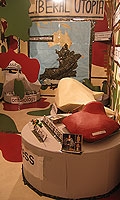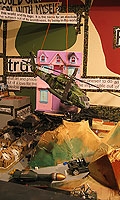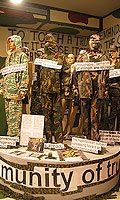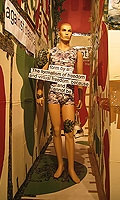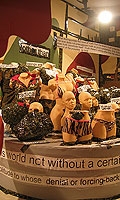Feature: Reviews
Thomas Hirschhorn
- Wattis Institute for Contemporary Arts
- California College of the Arts, San Francisco
- March 10 - May 13, 2006
UTOPIA UTOPIA = ONE WORLD ONE WAR ONE ARMY ONE DRESS
Rather than a review, this will be a gathering of my first impressions. Usually, I approach new art with the question, “What is this?”. But at Thomas Hirschhorn’s exhibition at CCA, I never got to that question, because at first sight, I was knocked out. Here is an artist affirming that art is communication, above all and against all the odds.
Taking up the two floors of the Wattis Institute galleries, the cave-like, large-scale installation is dense with visual imagery and complex text. It is crammed with photographs, thousands of photographs of the wars and genocides of the past fifteen years, presented on tables covered with camouflage cloth. It is packed with painted camouflage patterns and biomorphic-shaped, camouflage-colored mobiles.
The space is crowded with large-scale floorstanding cardboard fuselage shapes and wood candelabra-like floorstanding shapes with mannequin and doll heads sprouting camouflage-tape tumor shapes where candles would be, like cancerous Hannukah candelabra.
In one corner, a multi-storied doll’s house, inhabited by toy people: men, women and children revealed here to be all dressed in camouflage as though by an X-ray, all warriors in a war. Their surroundings—kitchen, living room and bedroom—are all in camouflage. Turning around, I see a large cardboard fuselage shape close by. I stand between the life-size fuselage and the model-scale suburban house occupied by suburbanites, their inner lives invaded by war.This corner of the exhibition, powerful because of the extreme shifts in scale, reminds me of the William Kentridge film, Weighing…Wanting (l998), a film that shows through drawing, erasure of outline, and accretion of more drawing, that the outside is inside, that political context and national history become an individual’s innermost self.
There are modern art corners: camouflage tape against white wall making geometric abstractions referencing Mondrian’s utopian vision; a Duchamp wall of repeated framed, cracked and taped glass referencing the Large Glass and the body as machine; the Andy Warhol post, his self-portrait in camouflage, the mid-century American artist who took on everything from capital punishment to camouflage and all-over abstraction.
The title of the exhibition, with “utopia” repeated for emphasis, is a sardonic reminder of the sad history of modernism’s utopian dreams of one world yielding the nightmare of one world united by war.
Specifically made for this country, first shown at Boston’s ICA, Utopia Utopia can be seen in the context of Dada’s reaction against formalism and the societal insanity of World War I. Most importantly, though, I see Hirschhorn’s work in the context of John Heartfield’s anti-Nazi photomontages and collages of the l930s and l940s. In this sense, Utopia Utopia is a three-dimensional collage in which, as in Heartfield’s work, juxtapositions of jarring imagery and text, as well as extreme shifts in scale, deliver an activist artist’s searing political message. Heartfield uses newspaper photographs selectively. Hirschhorn does so cumulatively, in a kind of desperate proving by numbers, to uncover the true nature of our political reality.
All of this elaboration and accretion of visual material is in the service, through engagement with the surface, of engaging us with the omnipresence of war. The hope in this dystopic vision comes from, in the artist’s words, “tunneling in,” or in a psychoanalytic sense, insight into one’s situation is energizing and has the potential to transform—which is the energy to act.
The exhibition is a bold affirmation of art as communication. Go with your eyes open and trust your experience of it, scrolling through the exhibition as you would computer text. It is important.

